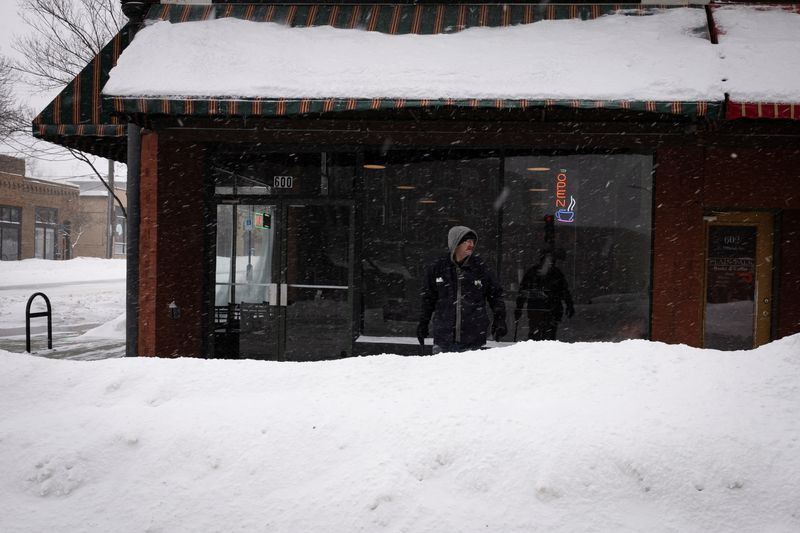Commodities
Frigid temps cut US natural gas supply as demand soars, Texas faces possible shortfall


© Reuters. FILE PHOTO: A man stands outside a coffee shop after a blizzard left several inches of snow, in downtown Des Moines, Iowa, U.S., January 13, 2024. REUTERS/Marco Bello/File Photo
By Scott DiSavino
(Reuters) – U.S. output fell to a preliminary 11-month low on Sunday as frigid weather froze wells across the country, while gas demand for heating and power generation was on track to hit record highs.
In Texas the state’s power grid operator, the Electric Reliability Council of Texas (ERCOT), forecast electric demand on Tuesday would top last summer’s all-time high and warned power supplies could fall short on both Monday and Tuesday.
ERCOT on Sunday issued an appeal to the public calling for energy conservation from 6 a.m. – 10 a.m. CT (1200-1600 GMT) on Monday.
The operator asked Texas government agencies to implement all programs to reduce energy use at their facilities during that time.
“Operating reserves are expected to be low Monday morning due to continued freezing temperatures, record-breaking demand, unseasonably low wind,” the grid operator said in a statement.
The drop in U.S. gas availability so far this week was the most in over a year, with supplies on track to fall by around 9.6 billion cubic feet per day (bcfd) from Jan. 8-14 to an estimated 11-month low of 98.6 bcfd on Jan. 14, according to data from financial firm LSEG.
That decline so far was small compared with gas supply losses of around 19.6 bcfd during Winter Storm Elliott in December 2022, and 20.4 bcfd during the February freeze of 2021.
In North Dakota, oil production was down by an estimated 250,000 to 280,000 barrels per day due to freezing weather, while gas output had fallen by 700 million to 800 million cubic feet per day, according to North Dakota Pipeline Authority.
Electricity supply and demand forecasts can change quickly, however, as power plant availability and weather patterns develop. The February 2021 freeze left millions in Texas without power, water and heat for days and resulted in over 200 deaths as ERCOT scrambled to prevent a grid collapse after an unusually large amount of generation shut.
Some of those power plants shut because they could not access enough gas supplies after frigid temperatures froze wells and other equipment, known in the energy industry as freeze-offs.
DEMAND SOARS
U.S. gas demand, including exports, will reach 164.6 bcfd on Jan. 15 and 171.9 bcfd on Jan. 16, according to LSEG.
Those daily demand forecasts would top the current all-time high of 162.5 bcfd set in December 2022 during Winter Storm Elliott, federal energy data from S&P Global Commodities Insights showed.
In Texas, ERCOT forecast power demand would peak at around 85,564 megawatts (MW) on Jan. 16 at around 8 a.m. local time, which would top the current all-time peak of 85,508 MW set in August 2023.
ERCOT estimated power use could top supplies by around 1,000 MW during the mornings of both Jan. 15 and Jan. 16. Those estimates, however, are subject to change and do not account for steps the grid operator may take to boost supplies and reduce demand.
One of the states hardest hit by the freeze over the past few days is Oregon, where roughly 164,000 homes and businesses were without power on Sunday, according to PowerOutage.us.
Portland General Electric (NYSE:), the state’s biggest power company, said in a post on social media platform X that restoration efforts would continue through the weekend. Portland General had about 126,000 customers still without power at midday on Sunday.
Next-day power prices at the Mid-Columbia (Mid-C) hub at the Washington-Oregon border soared to a record high of around $1,075 per megawatt hour (MWh), according to LSEG data going back to 2010.
That compares with Mid-C averages of $81 per MWh in 2023 and $52 from 2018 to 2022.
Northwest Pipeline, which supplies gas to states including Washington, Oregon, Idaho, Wyoming, Utah and Colorado, on Saturday declared force majeure following an outage at a gas storage facility but has since resumed operations, company notices said.
Officials at U.S. energy company Williams Cos, the pipeline’s owner, said on Sunday challenges on the pipeline had been resolved and that its transmission systems were continuing to transport scheduled volumes.
Commodities
Oil prices rise; U.S. crude inventories plunge, Russia-Ukraine truce eyed
Commodities
India’s Reliance to stop buying Venezuelan oil over US tariffs, sources say
Commodities
Oil prices climb on Venezuela supply worries

 Forex3 years ago
Forex3 years agoForex Today: the dollar is gaining strength amid gloomy sentiment at the start of the Fed’s week

 Forex3 years ago
Forex3 years agoUnbiased review of Pocket Option broker

 Forex3 years ago
Forex3 years agoDollar to pound sterling exchange rate today: Pound plummeted to its lowest since 1985

 Forex3 years ago
Forex3 years agoHow is the Australian dollar doing today?

 Cryptocurrency3 years ago
Cryptocurrency3 years agoWhat happened in the crypto market – current events today

 World3 years ago
World3 years agoWhy are modern video games an art form?

 Commodities3 years ago
Commodities3 years agoCopper continues to fall in price on expectations of lower demand in China

 Economy3 years ago
Economy3 years agoCrude oil tankers double in price due to EU anti-Russian sanctions























